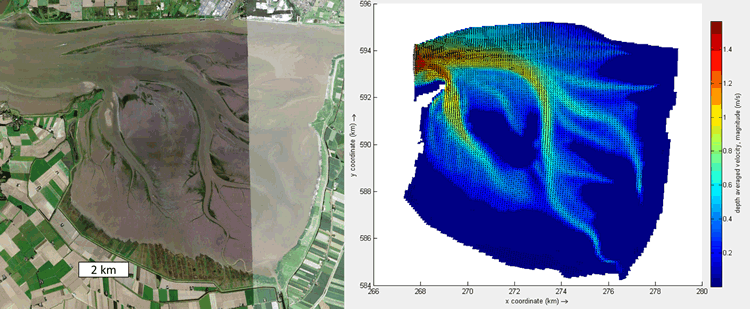J.R.F.W. Leuven1,2*, B. de Vries1, D.S. van Maren3, C. Schmidt4, P. Dankers1
1 Royal HaskoningDHV,
2 Wageningen University & Research,
3Deltares,
4Rijkswaterstaat WVL,
Introduction
The Ems-Dollard estuary is characterised by a very high turbidity and is under pressure of sea-level rise and other human influences, similar to many other estuaries worldwide. The high turbidity reduces primary production, which disturbs the food web and decreases the ecological quality of the estuary. One of the measures that has been proposed to reduce the mud in the water column and to keep up with sea-level rise is enhancing the sedimentation process within the Dollard basin of the estuary. Here we investigate the potential of enhanced mud sedimentation for improving the water quality and thereby improving the ecological quality and growing with sea-level.
Methods
We designed ten potential measures to enhance mud sedimentation together with a team of experts from Dutch universities and knowledge institutes. The three most promising measures were selected based on a detailed qualitative analysis. These measures are: (1) create low energetic conditions with organic shapes of brushwood groynes (2) create a small lagoon by excavating a small part of the salt marshes (3) lower and rejuvenate salt marshes periodically. Subsequently, these three measures were implemented in a calibrated local Delft3D flow and wave model of the Dollard with a 100x100m grid. Boundary conditions are derived from a larger model of the entire Ems-Dollard estuary. Processes that steer the long-term autonomous evolution of the estuary, including for example sea-level rise, , were also included in the model.
Results
Our results will show which measures are most promising for enhancing mud sedimentation and extracting mud from the water column. The model results will indicate the maximum sedimentation speed that can be reached per year when measures are taken, in contrast to the 0-1 cm per year without measures presently. Besides morphological modelling, we will also assess the ecological effects and costs of the proposed measures. Together this will lead to a choice for the most promising and cost-effective solution. Enhanced sedimentation measures can help drowning delta's and estuaries in the future, because it increases the capability to grow with sea-level rise.

Figure 1 [left] Aerial photography of the Dollard basin along the Ems-Dollard estuary (source: google earth). [right] Example of model output with peak ebb flow velocities.
I. Surname1*, F.N. Another-Surname2 , Y. Next-Surname2
1 University Name, Country; 2 Organization Name, Country
* Corresponding author: mail.name@organization.org


